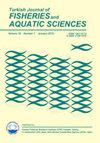Length Based Assessments for European Pilchard Sardina pilchardus and European Anchovy Engraulis encrasicolus, in the İzmir Bay, Aegean Sea
IF 1.7
4区 农林科学
Q3 FISHERIES
引用次数: 0
Abstract
In the Mediterranean Sea, European pilchard Sardina pilchardus and European anchovy Engraulis encrasicolus are the most important small pelagic fish regarding their ecological role, and revenue. Here, we perform a comprehensive assessment of length-based methods for those small pelagics from İzmir Bay, Aegean Sea. Therefore, the Length-based Bayesian Estimator and Length-based Spawning Potential Ratio were used to evaluate the stock structure and status of two important small pelagic fish. The length range for Sardina pilchardus was from 7.1 cm to 17.3 cm in TL. The ratios Lmean/Lopt and Lc/Lc_opt were over 1, suggesting truncated length structure and fishing of not too small individuals. The proportion of mature individuals in the catch was far less than half (36%) suggesting that in these fisheries catch consists mostly of immature individuals. The length range for Engraulis encrasicolus was from 5 cm to 15 cm in TL. The ratios Lmean/Lopt and Lc/Lc_opt were over 1 (1.2 and 1.3, respectively), suggesting truncated length structure and fishing of large individuals. The proportion of mature individuals in the catch was over half (52%) suggesting that in these fisheries catch consists of adults. The estimated sizes at median 50% selectivity (SL50) for S. pilchardus (11.1 cm) was ∼0.6 cm shorter than its lengths at 50% maturity (L50) of 11.7 cm, which indicates that a large proportion of the catch was immature. The median estimate of the spawning potential ratio was ∼0.19 for S. pilchardus and ∼0.48 for E. encrasicolus.爱琴海伊兹密尔湾欧洲沙丁鱼和欧洲昂船鱼的基于长度的评估
在地中海,就其生态作用和收入而言,欧洲沙丁鱼和欧洲鳀鱼是最重要的小型中上层鱼类。在这里,我们对来自爱琴海伊兹密尔湾的小型群岛的基于长度的方法进行了全面评估。因此,使用基于长度的贝叶斯估计和基于长度的产卵潜力比来评估两种重要的小型中上层鱼类的种群结构和状态。在TL中,沙丁鱼的长度范围为7.1cm至17.3cm。Lmean/Lopt和Lc/Lc_opt的比值超过1,表明其长度结构被截断,个体不太小。捕获物中成熟个体的比例远低于一半(36%),这表明在这些渔业中,捕获物主要由未成熟个体组成。在TL中,Engraulis encrasicolus的长度范围为5 cm至15 cm。Lmean/Lopt和Lc/Lc_opt的比值超过1(分别为1.2和1.3),表明其具有截短的长度结构和大型个体的捕捞能力。捕获物中成熟个体的比例超过一半(52%),这表明在这些渔业中,捕获物由成年个体组成。在中位50%选择性(SL50)条件下,毛颡鱼(11.1 cm)的估计尺寸比其50%成熟度(L50)条件下的长度(11.7 cm)短约0.6 cm,这表明很大一部分渔获物是未成熟的。产卵潜力比的中位数估计值为:毛细孔藻约0.19,圆孔藻约0.48。
本文章由计算机程序翻译,如有差异,请以英文原文为准。
求助全文
约1分钟内获得全文
求助全文
来源期刊

Turkish Journal of Fisheries and Aquatic Sciences
FISHERIES-MARINE & FRESHWATER BIOLOGY
CiteScore
3.10
自引率
0.00%
发文量
43
审稿时长
3 months
期刊介绍:
Turkish Journal of Fisheries and Aquatic Sciences" (TrJFAS) is a refereed academic journal has been published by Central Fisheries Research Institute of Turkey and Japan International Cooperation Agency (JICA), and published in English.
It aims to address research and needs of all working and studying within the many varied areas of fisheries and aquatic sciences.
The Journal publishes English language original research papers, critical review articles, short communications and technical notes on applied or scientific research relevant to freshwater, brackish and marine environments.
TrJFAS was published biannually (April & November) between 2001 and 2009. A great number of manuscripts have been submitted to the journal for review from acceptance of the SCI index. Thereby, the journal has been published quarterly (March, June, September and December) from 2010 to 2017. The journal will be published monthly in 2018.
 求助内容:
求助内容: 应助结果提醒方式:
应助结果提醒方式:


